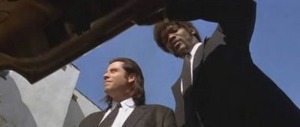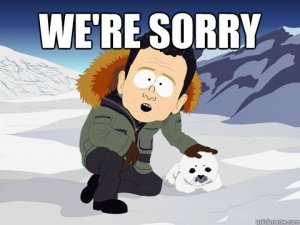Dear Internet and my thousands upon thousands of loyal followers, fans, and groupies,
I regret to inform you that this may be my last writing to you. This post is to give one last insight on the process behind the construction of my final product. We’ve had good times: the manager at Wal-Mart giving me the stink eye and confronting me about taking pictures of the meat aisle. We’ve had the bad times: my mindless rantings about my disdain for my chemistry teacher. Yet what matters internet, is that we’ve been here for each other the whole way through.
But enough reminiscing. Time to get down to brass tacks and talk about my final product. I have pretty much finished up my product. Currently it is done and I am rather pleased with it. I feel that the picture i took was a nice backdrop for my message and that it is all packaged and prepared rather well. Now that I’m done prettying it up, i just have to prepare to actually present it. I don’t have any classes tomorrow so I plan on devoting all day to preparing my notecards and outline to ready myself to present 2nd after Jem on monday.
I think the majority of my presentation is just going to be drawn from my justification paper. Pretty much all of my ideas and thoughts, I put into that paper. One of my major fears is that I will get side tracked and ramble because I honestly feel like I could do a 20 minute presentation over this assignment. Don’t get me wrong. The 7-10 minute benchmark is perfect. I have just really enjoyed this assignment and the thought process and just creative process that went into creating it.
Yours’ truly,
That guy from class that’s always wearing the Bears hat, Lucas
“The writer A.J. Liebling once said that freedom of the press belonged only to those who owned one. Explain why you agree or disagree.”
I personally agree with this statement. In the years prior to the internet and the many different publications that we can have brought to our doorsteps, not just anybody could knock on the door and have the paper run their article. Journalists and others who gathered what was deemed news amassed their stories and information and the publication as a business decided what to run in their printed paper. The fact that the everyday person didn’t own a printing press was the very reason as to the restriction from a press. You can’t exactly take advantage of a resource that isn’t there. Yet, I see where there has to be a line drawn. I don’t own a firearm of any kind, but I feel that I should still have the right to own a gun. I technically have my 2nd amendment right to own that gun, as the same as I have the freedom of the press. Yet the fact that I own neither a gun nor a printing press is a statement as to my indifference to being entitled to exercise that freedom. I feel like it is saying that a person that cannot speak or communicate in any way, does not have the right to free speech. It doesn’t really matter because they cannot communicate anyway, but does it matter that the implication is that if they could speak, that they do have that right. I’m having a hard time communicating my exact idea on the matter because this is a one-sided blog. I talk you read. There is no real back and forth for me to make sure you’re understanding what I mean, but I’m going to hope that I have explained it enough so you can understand what I mean.
In today’s culture though, there are so many technological advances that have turned almost every electronic device into a “press”. You want to express your ideas and feeling? Start a blog. That is your press. You hit publish and you have, for free, created a product that is pushed into the media at an infinite number of copies. You want your friends and fans to know what your up to? In 120 characters or less, you can “tweet” your own personal little installment to your 6 followers. Your Facebook even acts as a personal and recreational resume and yearbook. Your life is on that thing and to anyone you choose, you can push your product (albeit your Facebook page) into anyone on the internet’s face. I understand that as technologies change, that laws have to change as technology changes in some cases but I still believe that Liebling’s statement is still factual. Until you exercise and show that you have that right you might as well not even have it at all. Currently almost everything is a “press” in a sense, therefore everybody owns a press. It’s simply adapting your understanding as we progress as a society. Sure, everybody knows that you’re not supposed to discharge a firearm within so many hundred yards of a school or place of worship, but there’s no law against detonating a proton torpedo within school property. It’s just all using common sense to rationalize what makes sense.
“How would you go about formulating an ethical policy with regards to using deceptive means to get a story?”
My main ideas about this question go along with what Josh said in class, the level of deception and foul play involved with getting a story should be directly relative to whether it involves a public or private citizen. A public citizen (more along the lines of political publicity) is going to be more vulnerable to attempted deception by the media to get a story. That seems to me to simply be a side effect of that publicity. Like Jonathan referenced in class, the scene from Thank You For Smoking where Katie Holmes character sleeps with Aaron Eckhart’s character in order to get a story out of his pillow talk. Yes, his character is a person with a son and a life, but his publicity is completely due to the fact that he is a lobbyist for “big tobacco”. That was a situation where it wasn’t the person that was deceived as much as the position. That is the main point that I think draws the line. A public citizen is not pursued for themselves, they are chased because of the position they hold.
A private citizen deserves much more respect in the media than a public citizen. Any news coverage of a private citizen should be conducted in a manner that is considerate to the fact that they are reporting on a person, not a position like the case of a private citizen. A private citizen does not have the PR people and training that a public citizen would have. A private citizen is not going to have the conditioning to better handle that aggressive and deceptive means and is more likely to fall prey to these mannerisms.
Those are basically my simple ideas as to what is ethical treatment of private vs. public citizens. That is roughly what any policy i would construct would consist of, but there has to be that line somewhere. I personally dislike deception in the media because that just seems to be a rude sly tactic to get information that could be very unethical. But I suppose that in some cases, its usefulness could be argued against certain situations, but over all I think that most deceptive tactics use for todays journalism would simply be overkill to any important stories that need to be covered. Yet I do hold to the fact that in some situations, the ends do justify the means when it comes to sneaky and even unethical journalism.
This post is to act as another update as to my final product.
I currently have the picture and have started messing around in editing software to try to get the right color and tone to it. I find it worth mentioning that I changed the idea of my picture. Instead of having a steak marinating in bleach or anything like that, I decided to get a picture of the meat section of a grocery store. I feel like this actually brings the problem to a more personal level with the fact that it is actually lurking in your meat section at Wal-Mart or where ever you choose to buy your meat. I reminds me of the Quentin Tarantino-esque idea of the camera angle looking out of the trunk of the car from Pulp Fiction and Reservoir Dogs.
The next thing to do is decide exactly what I want the text to say and what color and what font I use. I actually plan to spend some time deciding this. I had never really thought about all of this until it was actually something I had to do. I never thought about the font or color or signs or billboards as I passed by them but now that I am working with this, it actually does matter. But there is one font that I’m smart enough to stay away from…
So this post is to speak about my progress as to my final product.
I currently have:
My idea
…… and that is about it… My main tasks are to take the picture, edit the picture, and then find a company or place that will print my poster to the desired size. That is basically all their is to it. I plan to play around in photoshop to figure out exactly how to make my picture look right (darker colors, emphasis on the bleach and meat etc.).
and that is about it… I will have more to share in future posts but for now, that is all.
“What do you think of when you hear the term public relations? What images come to mind? Where did these impressions come from?”
Honestly, when I hear public relations, I immediately think that a company has done something to mess up and is now sending out an agent or just an employee to try to cover it up and make it all better. I instantly think about the whole joke that South Park made when the whole BP oil spill fiasco was still headline news. They showed hilarious commercials on the show that were trying to apologize for the whole thing. The funny part of the commercials on South Park is that instead of just saying they were sorry, it was the CEO of BP dealing with cure baby animals and doing nice things in public, there are also ones of him in awkward poses without a shirt on as if to sexually seduce the viewers while saying “we’re sorry” in very awkward tones. That may not be the best image that could come from the phrase public relations, but that’s what pops into my head.
But why do I automatically assume that a company is in trouble when I see a public relations person on tv or in a commercial? I think it is simply because only when something bad happens, do I actually pay enough attention to the news as to see a PR person. That is really what it boils down to. I don’t ever see a PR person or representative unless something bad has happened with the company or if they are being sued or what not.
Up until this point, I will admit that I have been almost completely oblivious to PR influences outside of a negative situation. PR people do not only deal with problems and lawsuits, they deal with public relations period. commercials and billboards and even minute details of advertising that I would not even think related to PR, but it does because in and of itself, advertising is the most positive form of PR that is out there.
This blog post is to describe the mediated product that we will be submitting as our final project for the class. I neglected to do my blog post explaining my choice of medium due to already having a 20 point extra credit, but I intend on making a type of public service poster. Not unlike the ones I have subjected to the critical process in my previous blog posts.
The biggest part of creating a poster of the sort is the fact that you need an image that will grab an audience’s attention like the blood in the poster in my People Notice Blood post. this can be done with loud colors or an intense picture, but I wanted to concentrate more on the actual content of the image instead of ways of catching people’s’ eyes with image trickery.
My idea concerns the content of the food that you unquestionably shove into your mouth. Recent uproar has come about due to the “pink slime” that is a term referring to ground beef that has been treated with ammonia and deemed safe to eat by our very own FDA. this is going to be the focus of my poster. How you should probably be concerned with what is considered safe to eat.
My plan is to showcase the treatment of this meat by either showcasing a steak or other meat marinading in a bag of bleach as if it were steak marinade. In the bottom corner of the picture would be a phrase like “Ammonia! It’s what’s for dinner” or “Where’s the bleach?!” Another idea would be to have a picture framed from inside of a lunch cafeteria’s kitchen facing out of the door where you can see the back of the lunch lady as she interacts with the children. Then have a bottle of ammonia in the foreground on a table and the background is the interaction of the lunch lady giving the children the food. The bold text of the poster would say something to the tune of “Eat up kiddies, it’s packed full of NH3! Know what the FDA says is safe for your children to eat.” Even though this is a gross over exaggeration, it is an accurate representation of what the FDA is allowing companies to do concerning meat. I still have a lot of research I want to do before my presentation and oral report, but I feel like I can have a good bit of information on this topic simply due to the magnitude of the problem at hand.
“Imagine that you are on a committee that oversees book choices for a high school library in your town. What policies do you think should guide the committee’s selection of controversial books?”
Being 18 and just out of high school, the 1st thing that comes to mind for me personally is the fact that, other than obviously obscene books with nothing but graphic content, I don’t want anybody telling me what I can’t read. Having just watched “Footloose” (Kevin Bacon’s; the new one is trash) the idea reminds me of a scene where a parent and the reverend are talking about trying to get the book “Slaughterhouse 5” removed from the curriculum simply because of the name.

Mr. Gurntz: He was trying to teach that book.
Mrs. Allyson: Slaughterhouse-Five, isn't that an awful name?
Ren: Yeah it's a classic... Slaughterhouse-Five, it's a classic.
Mr. Gurntz: Tom Sawyer is a classic! Do you read much?
Mrs. Allyson: Maybe in another town it's a classic.
Ren: In any town.
To answer the question, I think that the committee’s job should simply be to make sure that the books in the school’s library are explicitly graphic like a playboy magazine or the like. I personally feel that it being a high school library, the kids there should be mature enough and wanting to be on more of an educational level that they should respect anything that is published as a form of art or genuine media that they could learn from. Just like our conversation about the PC censorship of Tom Sawyer and Huck Finn, that was a period of time where that was acceptable. It is not solely directed to target black people and Native Americans and degrade them, it’s simply something written in a book that stands for a historical point in media.
If you tried to draw a line between the books that are okay and which ones are not due to violence or subject matter that seems to me to be a very subjective basis. It reminds me of the movie we watched in class, “This Movie Is Not Yet Rated”, where the phantom-like board gets to put the axe to anything that they deem to be unfit. A board that sat in to decide which books are okay to put in a high school library would be exemplifying the exact ideal of the board that judges the movies. The result of this being lack of the spread of knowledgeable media. If tomorrow, every copy of Slaughterhouse 5 was taken off of school shelves, what have we gained? A win for the parents who think the name of the book was a bad influence on their children? Your child is in high school, i promise you they’ve heard worse than “slaughterhouse”. But back to what i was saying: there is no win from that situation. There is simply a loss of that book and the knowledge contained within it. After that book is taken away, the question is which book is next? and after that? Creating a subjective system of deciding which books would be okay for a high school library is something that would be done with good intentions, and horrible results.
So what policies would I instate to protect the youth of our towns high school? I would simply make sure that nothing receiving a XXX rating ended up on the shelves. Anything more intrusive than that and i believe that it begins to cut into the opportunities that children should have concerning the books that they are given access to.
This week’s subject to the critical process is a commercial made by the Alaskan Mobility Coalition. It’s a commercial to raise awareness within the Alaskan population about the importance of their public transportation system.
The 1st step is to describe. The video is a time-lapse at the beginning of congested traffic flowing. It then shows a montage of busses going in the diverse situation where public transportation is available (urban, suburban, far spans of highway). Then it shows the same thing with the vans provided by the Alaskan public transportation. It then shows people on the buses sitting and talking and aiming to show just how much fun they’re having on their bus ride.
Analyze: It shows the busses 1st. With people boarding the busses and then a few “action shots” of the busses gallantly traversing the Alaskan roads. it then shows the same thing with the large commercial vans. People boarding, then the vans driving around in the cities and around the town. Then it goes to a montage of action shots of both vans and busses. Next, it shows a handicapped scooter being put on the bus to show that it is handicapped accessible, then it shows a person loading a bike onto the front rack of the bus to show that there is a place for you to store your bike if you choose to ride the bus. then the 2nd to last shot is of a woman talking to someone off camera and smiling to show she is enjoying her experience on the bus. Then the last shot is a landscape shot with the Alaska Mobility Coalition logo. The audio of the video is elevator music with a overdubbed woman talking about the use of public transportation and the importance of it.
Evaluate: This video has quite a repetitive pattern and serves really no more purpose to show the viewer the resources of the Alaskan public transportation system and to show the friendliness of the other people that utilize the system.
Question: Do you remember seeing a movie that you were not allowed to see? Discuss the experience.
Me and my little brother, Caleb, have never been really big fans of horror movies. We have never really been fans of listening to our mom either. So one summer when we asked if we could watch Stephen King’s “IT” and our mom told us no, there was only one thing we could do.
We found the movie in our parents movie cabinet where they kept all the violent movies that they didn’t want us watching like “The Terminator” and “Braveheart”. It was on a recordable VHS because my mom had painstakingly taken the time to watch the movie while it was on tv and pause the recording to edit out any commercials old-school style. We popped the movie in and watched the whole thing in one sitting. I’ll admit, the movie was terrifying to a kid in between 5th and 6th grade, but me and my little brother would reassure ourselves that it was okay and that we weren’t scared by occasionally laughing and looking at each other. We also knew that we were doing this in order to look away from the tv at a really scary time so we wouldn’t have to face the horror being displayed on the screen.
We watched the movie around noon and finished it unphased. We eagerly awaited the hour of our mom’s return from work so we could tell her we’d watched the movie and that we weren’t scared at all. She finally got home after what seemed like forever as we waited with baited breath. We jumped around and told her how we’d watched the movie and it wasn’t scary at all! It wasn’t scary… until 3am when me and my little brother were both laying in our beds terrified to move. One of us finally decided to say something and let the other one know that he was still awake too. So we sprinted down the stairs and jumped onto the couch in the playroom. We were too scared to sleep in our own room for 3 more nights until we had built up the courage to get back into our own beds at night.
I learned a very valuable lesson through that experience. No matter what age you are, or how many people you are with, NEVER. WATCH. THAT. MOVIE.






